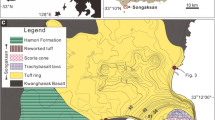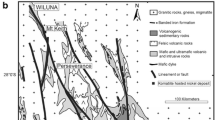Abstract
The Etendeka Formation of north-western Namibia consists of a sequence of interbedded quartz latites and tholeiitic basalts and forms part of the Karoo Igneous Province in southern Africa. The age of the Etendeka Formation is approximately 130–135 Ma. The quartz latites make up a significant proportion of the stratigraphic succession (<25% of the total stratigraphic thickness) and form as much as 60% of the outcrop area in the southern Etendeka. Apart from some systematic differences between pitchstones and devitrified quartz latite, largely explained by alteration processes, individual quartz latite units exhibit remarkably uniform compositions with no significant vertical or lateral variation. Geochemistry can be used as a primary criterion for the correlation of major quartz latite units over much of the southern Etendeka area enabling the reconstruction of the Etendeka Formation stratigraphy in this region. Individual quartz latite units occur as voluminous (400–2600 km3), widespread (up to 8800 km2), sheet-like deposits typically between 40 and 300 m thick. Each unit consists of basal, main and upper zones. The main zone generally constitutes over 70% of the thickness of the unit and typically consists of texturally featureless devitrified quartz latite. In contrast the basal and upper zones of the flow are characterised by flow banding, pitchstone lenses and breccia, with rare occurrences of pyroclastic textures. The quartz latites are sparsely porphyritic (<10% phenocrysts) with glassy or devitrified groundmass textures. The phenocrysts consist of plagioclase, pyroxene, titanomagnetite and rare ilmenite. Pyroxene geothermometry indicates high (1000–1100°C) temperatures of crystallisation which, coupled with the absence or primary hydrous phases, indicates that the quartz latites were relatively hot, H2O-undersaturated magmas. The quartz latites display features common to both rhyolite lavas and ignimbrites and are clearly the products of an unusual eruption style. The local preservation of pyroclastic textures and the broad areal extent of these units lead to the conclusion that the quartz latites are high-temperature rheomorphic ignimbrites (i.e. rheoignimbrites). A combination of high eruption temperature and relatively low viscosity helps to explain the often completely welded and homogeneous textures observed in most quartz latite outcrops in the Etendeka area.
Similar content being viewed by others
References
Bellieni G, Comin-Chiaramonti P, Marques LS, Melfi AJ, Nardy AJR, Papatrechas C, Piccirillo EM, Roisenberg A, Stolfa D (1986) Petrogenetic aspects of acid and basaltic lavas from the Paraná plateau (Brazil): geological, mineralogical and petrochemical relationships. J Petrol 27:915–944
Bonnichsen B, Kauffman DF (1987) Physical features of rhyolite lava flows in the Snake River Plain volcanic province, southwestern Idaho. Geol Soc Am Spec Paper 212:119–145
Cas RAF, Wright JV (1987) Volcanic successions: modern and ancient. Allen & Unwin, London Boston Sydney Wellington:528 pp
Christiansen RL, Hildreth W (1989) Voluminous rhyolitic lavas of broad extent on the Yellowstone Plateau. Abstr Int Volcanol Congr, New Mexico, USA, p 52
Cleverly RW (1979) The volcanic geology of the Lebombo moncline in Swaziland. Trans Geol Soc S Afr 82:343–348
Cleverly RW, Betton PJ, Bristow JW (1984) Geochemistry and petrogenesis of the Lebombo rhyolites. Spec Publ Geol Soc S Afr 13:171–194
Cleverly RW, Bristow JW (1982) Flow banded and contorted tuffs: examples from southern Africa (Lebombo province) and western North America. Geol Soc Am Abstr with programs 14:p 464
Duncan AR, Newton SR, van den Berg C, Reid DL (1989) Geochemistry and petrology of dolerite sills in the Huab River valley, Damaraland, north western Namibia. Communs Geol Surv Namibia 5:5–17
Ekren EB, McIntyre DH, Bennett EH (1984) High-temperature large-volume, lavalike ash-flow tuffs without calderas in southwestern Idaho. Prof Paper US Geol Surv 1272:1–73
Erlank AJ, Marsh JS, Duncan AR, Miller RMcG, Hawkesworth CJ, Betton PJ, Rex DC (1984) Geochemistry and petrogenesis of the Etendeka volcanic rocks from SWA/Namibia. Spec Publ Geol Soc S Afr 13:195–245
Harris C, Smith HS, Milner SC, Erlank AJ, Duncan AR, Marsh JS, Ikin NP (1989) Oxygen isotope geochemistry of the Mesozoic volcanics of the Etendeka Formation, Namibia. Contrib Mineral Petrol 102:454–461
Harrison TM, Watson EB (1984) The behaviour of apatite during crustal anatexis: equilibrium and kinetic considerations. Geochim Cosmochim Acta 48:1467–1477
Hay RL, Hildreth W, Lambe RN (1979) Globule ignimbrite of Mount Suswa, Kenya. Geol Soc Am Spec Paper 180:167–175
Head JW, Wilson L (1989) Basaltic pyroclastic eruptions: influence of gas-release patterns and volume fluxes on fountain structure, and the formation of cinder cones, spatter cones, rootless flows, lava ponds and lava flows. J Volcanol Geotherm Res 37:261–271
Henry CD, Wolff JA (1992) Distinguishing strongly rheomorphic tuffs from extensive silicic lavas. Bull Volcanol 54:171–186
Henry CD, Price JG, Rubin JN, Parker DF, Wolff JA, Self S, Franklin R, Barker DS (1988) Widespread, lavalike silicic volcanic rocks of Trans-Pecos Texas. Geology 16:509–512
Hildreth W (1979) The Bishop Tuff: evidence for the origin of compositional zonation in magma chambers. Geol Soc Am Spec Paper 180:43–75
Korn H, Martin H (1954) The Messum Igneous Complex in South West Africa. Trans Geol Soc S Afr 57:83–124
Le Maitre RW (1976) The chemical variability of some common igneous rocks. J Petrol 17:589–598
Le Maitre RW (ed), Bateman P, Dudek A, Keller J, Lameyre J, Le Bas MJ, Sabine PA, Schmid R, Sørensen H, Streckeisen A, Wooley AR, Zanettin B (1989) A classification of igenous rocks and glossary of terms: recommendations of the International Union of Geological Sciences subcommission on the systematics of igneous rocks. Blackwell Scientific Publications, Oxford London Edinburgh Boston Melbourne:195 pp
Lindsley DH (1983) Pyroxene thermometry. Am Mineral 68:477–493
Malin MC (1980) Lengths of Hawaiian Iava flows. Geology 8:306–308
Martin H, Mathias M, Simpson ESW (1960) the Damaraland subvolcanic ring complexes in South West Africa. Rep Int Geol Congr XXI Sess 13:156–174
Miller RMcG (1988) Geological map 2013 — Cape Cross, scale 1:250 000. Geol Surv SW Africa/Namibia
Milner SC (1986) The geological and volcanological features of the quartz latites of the Etendeka Formation. Communs Geol Surv S W Afr/Namibia 2:109–116
Milner SC (1988) The geology and geochemistry of the Etendeka Formation quartz latites, Namibia. PhD thesis (unpubl) Univ Cape Town:263 pp
Milner SC, Duncan AR (1987) Geochemical characterisation of quartz latite units in the Etendeka Formation. Communs Geol Surv S W Afr/Namibia 3:83–90
Milner SC, Ewart A (1989) The geology of the Goboboseb Mountain volcanics and their relationship to the Messum Complex. Communs Geol Surv Namibia 5:31–40
Nakamura Y, Kushiro I (1970) Equilibrium relations of hypersthene, pigeonite and augite in crystallizing magmas: microprobe study of a pigeonite andesite from Wieselberg, Germany. Am Mineral 55:1999–2015
Pirajno F, Schlögl HU (1987) The alteration-mineralization of the Krantzberg tungsten deposit South West Africa/Namibia. S Afr J Geol 90(4):499–508
Schmincke H-U (1974) Volcanological aspects of peralkaline silicic welded ash-flow tuffs. Bull Volcanol 38:594–636
Shaw HR (1972) Viscosities of magmatic silicate liquids: and empirical method of prediction. Am J Sci 272:870–893
Shaw HR, Swanson DA (1970) Eruption and flow rates of flood basalts. Proc 2nd CRB Symp:271–299
Smith RL, Bailey RA (1966) The Bandelier Tuff: A study of ashflow eruption cycles from zoned magma chambers. Bull Volcanol 29:83–104
Walker GPL (1973) Lengths of lava flows. Philos Trans R Soc London A 274:107–118
Walker GPL (1983) Ignimbrite types and ignimbrite problems. J Volcanol Geotherm Res 17:65–88
Walker GPL, Heming RF, Wilson CJN (1980) Low-aspect ratio ignimbrites. Nature 283:286–287
Whittingham AM (1989) Geological features and geochemistry of the acidic units of the Serra Geral Volcanic Formation, south Brazil. Abstr Int Volcanol Congr, New Mexico, USA, p 464
Woods AW (1988) The fluid dynamics and thermodynamics of eruption columns. Bull Volcanol 50:169–193
Author information
Authors and Affiliations
Rights and permissions
About this article
Cite this article
Milner, S., Duncan, A. & Ewart, A. Quartz latite rheoignimbrite flows of the Etendeka Formation, north-western Namibia. Bull Volcanol 54, 200–219 (1992). https://doi.org/10.1007/BF00278389
Received:
Accepted:
Issue Date:
DOI: https://doi.org/10.1007/BF00278389




